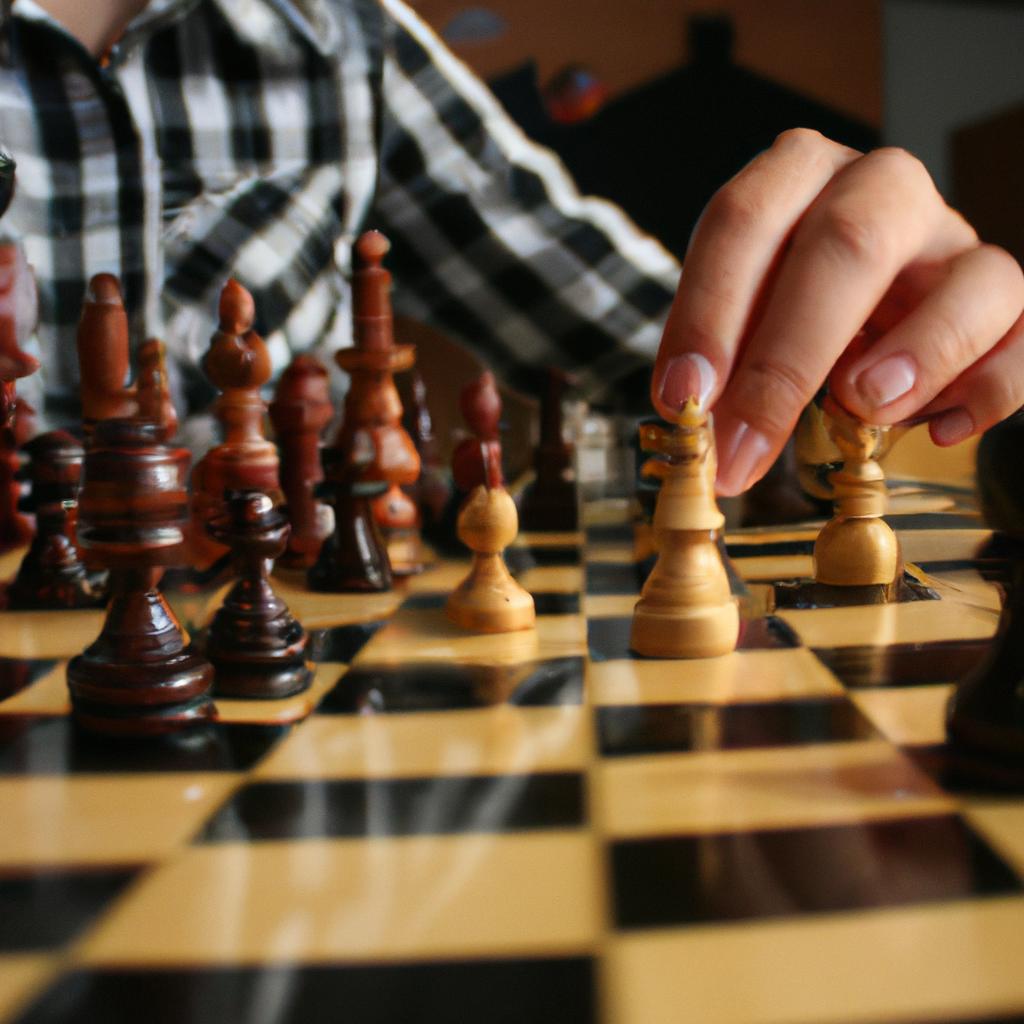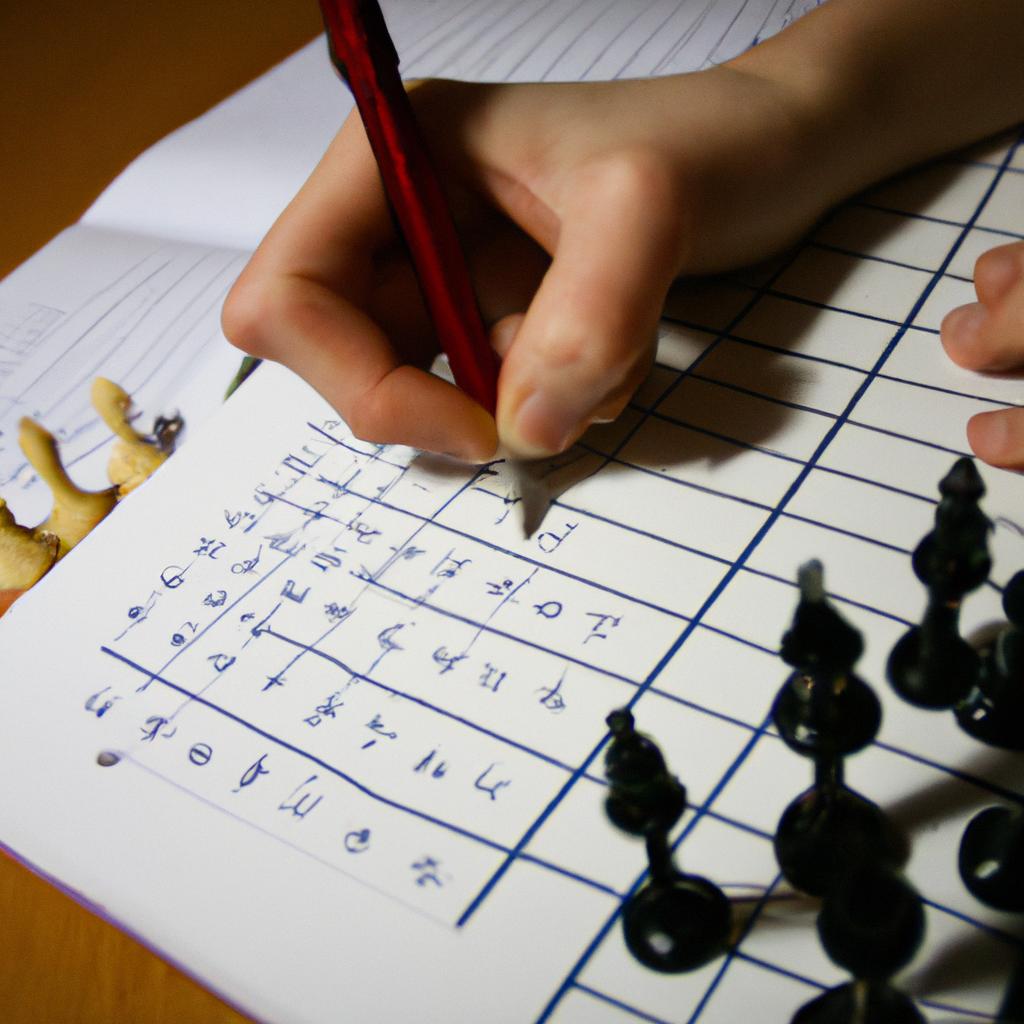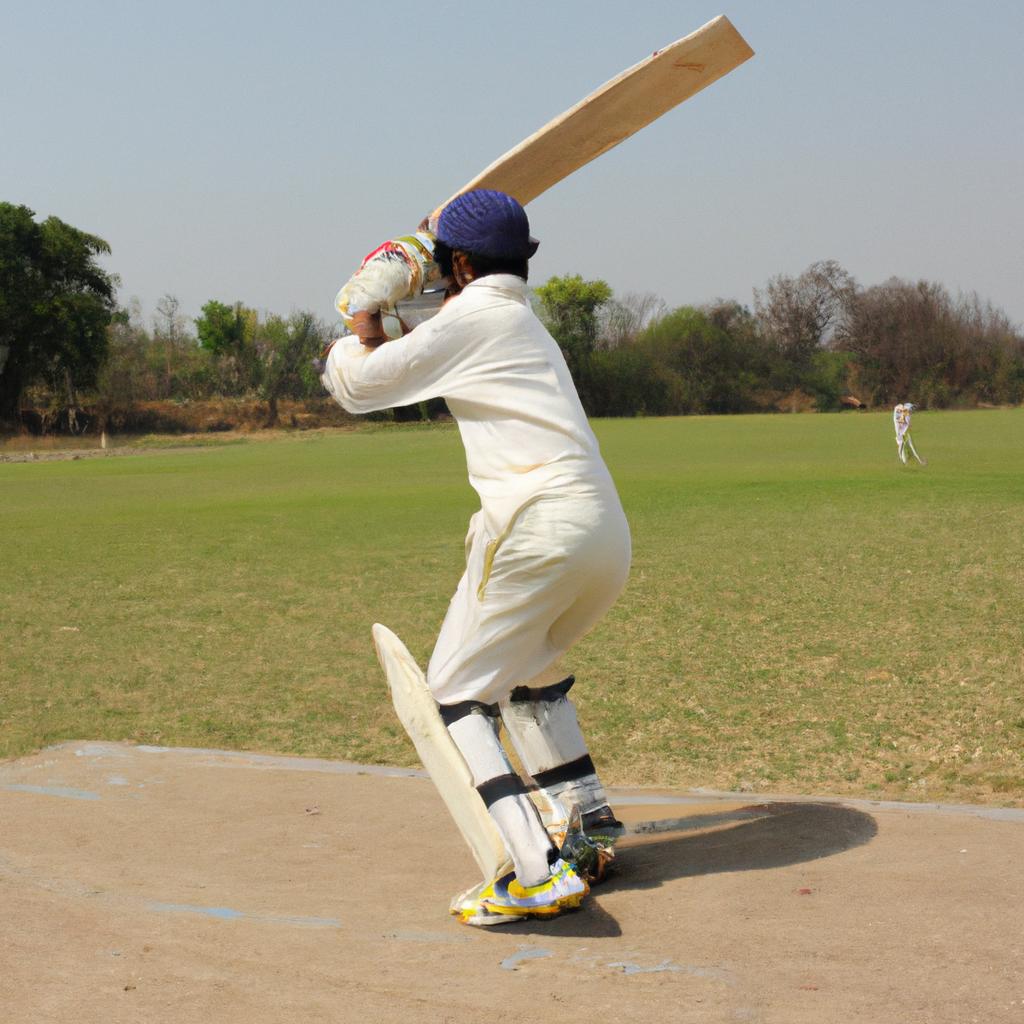Chess, a game of intellect and strategy, has long captivated the minds of enthusiasts worldwide. Its origins can be traced back several centuries to ancient India, where it was known as chaturanga. Over time, chess has evolved into a complex and highly competitive sport that demands both skill and foresight from its players. In this article, we will explore the intricacies of chess as a strategic game within the realm of games and sports.
Consider the scenario: two opponents sit across from each other at a wooden board adorned with intricate black and white squares. Each player meticulously arranges their army of sixteen pieces – pawns, knights, bishops, rooks, a queen, and a king – in preparation for an intense battle of wits. The objective is simple yet challenging: checkmate the opponent’s king while protecting one’s own monarch from capture. What unfolds on that chequered battlefield is not merely a clash between armies but also a brilliant display of mental agility and tactical prowess.
At its core, chess represents more than just moves on a board; it embodies strategic thinking at its finest. With millions of possible positions and countless combinations to consider with every move made by either side, players are forced to anticipate their opponent’s intentions while simultaneously developing their own plans. This requires a deep understanding of the game’s principles, such as piece value, pawn structure, and positional advantages.
Strategic thinking in chess involves assessing the current position on the board and formulating a long-term plan to achieve a favorable outcome. Players must evaluate the relative strengths and weaknesses of their pieces, identify potential threats, and exploit any opportunities that arise. They must also consider various factors like king safety, piece activity, central control, and pawn structure.
One key aspect of strategic play is piece coordination. By coordinating their forces effectively, players can create powerful attacks or mount solid defenses. For example, placing rooks on open files or diagonals allows for maximum influence over the board, while knights positioned in the center can control key squares and support other pieces.
Another important element of strategic thinking is creating imbalances in the position. Imbalances refer to asymmetries between both sides’ positions that can be exploited to gain an advantage. These imbalances can come from differences in material balance (number and quality of pieces), pawn structure (weaknesses or strengths), or king safety.
Furthermore, strategic thinking involves recognizing patterns and themes inherent in certain positions. Experienced players often rely on well-known strategies and ideas to guide their decision-making process. These include concepts like pawn breaks to disrupt opponent’s pawns chains or exchanging pieces when ahead in material to simplify the position.
It is worth noting that strategic thinking in chess goes beyond individual moves; it encompasses planning several moves ahead while considering multiple variations and contingencies. This ability to think strategically under pressure distinguishes top-level players from amateurs.
In conclusion, chess is not merely a game but a mental battleground where strategic thinking reigns supreme. The interplay of foresight, creativity, calculation, and evaluation makes chess an intellectually stimulating pursuit for enthusiasts worldwide. Whether played for leisure or at competitive levels, chess challenges individuals to sharpen their minds through strategic thought processes and tactical acumen.
Mastering Tactical Maneuvers in Chess
Chess, renowned as a game of strategic thinking and mental agility, requires players to anticipate their opponent’s moves while simultaneously formulating their own. One compelling example that showcases the importance of tactical maneuvering in chess is the famous “Immortal Game” played between Adolf Anderssen and Lionel Kieseritzky in 1851. In this riveting encounter, Anderssen sacrificed his queen to secure victory by exploiting positional weaknesses and employing calculated tactics. Such instances highlight the crucial role played by tactical maneuvers in achieving triumph on the chessboard.
To master tactical maneuvers in chess, players must develop a keen understanding of various strategies and techniques. The following bullet point list outlines key aspects for consideration:
- Calculation: Players need to meticulously calculate potential moves and counter-moves to assess their viability.
- Visualization: Mental visualization helps envision future board positions, enabling players to plan ahead strategically.
- Pattern recognition: Recognizing recurrent patterns facilitates quick decision-making during gameplay.
- Prophylaxis: Employing prophylactic moves guards against potential threats from opponents.
While these points provide a glimpse into the essential elements of mastering tactical maneuvers, an effective way to reinforce learning is through visual aids. Consider this three-column table that depicts different types of tactical maneuvers along with brief explanations:
| Tactical Manuever | Description | Example |
|---|---|---|
| Fork | Simultaneously attacking two or more pieces | Knight forks King and Queen |
| Pin | Restricting movement of an opponent’s piece | Bishop pins opposing Rook |
| Skewer | Forcing an opponent to move a valuable piece | Queen skewers King against back rank |
| Discovered Attack | Uncovering hidden attacks using another piece | Moving one piece reveals an attack from another |
By familiarizing themselves with these strategies and tactics, players can enhance their ability to outmaneuver opponents on the chessboard.
In summary, mastering tactical maneuvers in chess is essential for achieving success. Through calculated calculation, visualization, pattern recognition, and prophylaxis, players can develop a strong foundation in strategic decision-making. By utilizing visual aids such as tables and incorporating real-life examples like the “Immortal Game,” players are better equipped to understand and apply these tactical concepts effectively. With this knowledge under their belt, they can confidently progress into exploring the art of opening moves without missing a beat.
Exploring the Art of Opening Moves
By strategically positioning their pieces at the beginning of the game, players can gain an early advantage and pave the way for future success on the board.
Opening moves serve as a foundation for subsequent decisions and actions throughout a chess game. A well-executed opening move can dictate the tempo and direction of play, allowing players to control key areas on the board while simultaneously hindering their opponent’s progress. For instance, consider a hypothetical scenario where White opens with 1.e4 (moving their pawn two spaces forward). This move not only controls vital central squares but also facilitates development of both knights, providing flexibility in potential future attacks or defenses.
To further illustrate the significance of opening moves, here are some key points to consider:
- Openings establish solid foundations: Just like constructing a building requires sturdy groundwork, successful chess games rely on sound openings that set up favorable positions for later stages.
- Opening choices impact middle-game strategies: Different openings lead to distinct types of positions and require specific approaches during subsequent phases. The choice made at this stage affects how players develop their pieces and formulate long-term plans.
- Familiarity breeds efficiency: Expertise in particular opening variations allows players to make quicker decisions based on established principles rather than investing excessive time analyzing each move from scratch.
- Psychological effects come into play: Well-known openings often carry reputations established through past games by notable masters. Leveraging this knowledge can create psychological pressure on opponents or provide confidence boosts to those employing renowned strategies.
Table Example:
| Opening Name | Key Moves | Notable Players |
|---|---|---|
| Sicilian Defense | 1.e4 c5 | Fischer |
| Ruy Lopez | 1.e4 e5 2.Nf3 Nc6 3.Bb5 | Kasparov |
| French Defense | 1.e4 e6 | Carlsen |
| Queen’s Gambit | 1.d4 d5 2.c4 | Capablanca |
By Understanding the Importance of Opening Moves, players can approach their games with purpose and strategize effectively. The next section will explore effective approaches for the endgame, where a player’s grasp of tactics, positional play, and calculation becomes even more critical.
As we move forward to discuss effective approaches for the endgame, let us now delve into…
Effective Approaches for the Endgame
Transitioning from the art of opening moves, chess players delve into a crucial phase known as the middle game. This stage is characterized by intricate strategic decisions and tactical maneuvers that can ultimately determine the outcome of the match. To illustrate its significance, let’s consider a hypothetical scenario where two skilled players engage in an intense battle during the middle game.
Imagine a situation where Black has just executed a clever pawn sacrifice to gain control over the center of the board. In response, White must carefully assess their options and choose their next move wisely to maintain equilibrium on the board. The middle game becomes pivotal here, as both sides seek opportunities to exploit weaknesses, launch attacks, or fortify defenses.
To navigate this complex terrain effectively, chess players employ various techniques and strategies during the middle game. Here are some key approaches they utilize:
- Proactive Piece Development: Players focus on developing their remaining pieces to active squares while creating threats and applying pressure.
- Centralization: Occupying central squares with pawns and pieces allows for greater influence over the entire board.
- King Safety: Recognizing the importance of protecting one’s king becomes essential to prevent potential checkmate threats.
- Calculation Skills: Accurately calculating variations helps players anticipate potential outcomes and plan accordingly.
In addition to these approaches, chess players also implement specific tactics tailored to exploit opponents’ weaknesses or create advantageous positions. These tactics include forks (simultaneously attacking multiple targets), pins (restricting opponent piece mobility), skewers (forcing valuable pieces into vulnerable positions), and discovered checks (unleashing hidden powerful attacks).
To further understand how these tactics come into play during the middle game, refer to Table 1 below:
Table 1: Common Tactical Maneuvers in Chess
| Tactic | Description | Example Move |
|---|---|---|
| Fork | Simultaneously attacking two enemy pieces | Nc6 (Knight) |
| Pin | Restricting the movement of an enemy piece | Bb4 (Bishop) |
| Skewer | Forcing a valuable piece to move, exposing another | Re8 (Rook) |
| Discovered Check | Unleashing a check by moving one’s own piece | Qxg2+ (Queen) |
As players master these tactical maneuvers and strategies during the middle game, they gain an edge over their opponents. With each decision made intelligently, chess enthusiasts inch closer to victory.
Understanding Chess Notation Techniques allows players to record and analyze games effectively, enhancing their overall skill set in this captivating intellectual pursuit.
Understanding Chess Notation Techniques
Building on our understanding of chess strategy, let us now delve into effective approaches that can be employed during the endgame. In this section, we will explore key tactics and techniques used by skilled players to gain an advantage as the game nears its conclusion.
Paragraph 1:
To illustrate the importance of strategic thinking in the endgame, consider a hypothetical situation where both players have only a few pieces left on the board. Imagine a scenario where White has two pawns and a knight, while Black possesses a rook and three pawns. Although it may seem like Black has a more favorable position due to having more material, White can employ specific strategies to turn things around. By carefully coordinating their knight with the remaining pawns, White can create threats that force Black’s rook to remain defensive, ultimately leading to a successful checkmate.
- Maintain active piece coordination.
- Prioritize pawn promotion to stronger pieces.
- Control key squares and limit opponent mobility.
- Calculate variations meticulously before making moves.
| Approach | Description | Emotional Response |
|---|---|---|
| King Activity | Actively involving your king in the endgame helps control crucial squares and supports other pieces. | Confidence |
| Opposition | Positioning your king directly opposite your opponent’s king creates zugzwang situations and gains tempo. | Frustration |
| Passed Pawns | Advancing pawns towards promotion increases their value and puts pressure on the opponent’s defenses. | Hope |
| Piece Sacrifices | Calculated sacrifices can disrupt enemy formations, open up lines for attack, or facilitate pawn promotion. | Excitement |
Paragraph 2:
In addition to these general principles of play, there are specific techniques that experienced players utilize during the endgame. One such technique is the zugzwang, where a player would rather not make any moves because any action would worsen their position. This strategic concept forces opponents into unfavorable positions, allowing the player with initiative to take control of the game. Another effective approach involves sacrificing pieces strategically to gain an advantage or create tactical complications that can lead to victory.
Paragraph 3:
By employing these various strategies and techniques in the endgame, players can navigate through complex scenarios and increase their chances of success. The ability to think ahead, calculate variations meticulously, and adapt one’s plans accordingly becomes crucial during this phase of the game. As we move forward, let us now explore the lives and accomplishments of legendary figures in the chess world who have left an indelible mark on this ancient game.
Having examined effective approaches for the endgame, it is fascinating to delve into the lives and achievements of legendary figures in the chess world. These individuals have shaped and enriched the history of this captivating mind sport throughout centuries.
Legendary Figures of the Chess World
Section H2: Understanding Chess Notation Techniques
Having delved into the intricacies of chess notation techniques, it is now time to explore the legendary figures who have left an indelible mark on the world of chess. These individuals have not only showcased their exceptional skills and strategic prowess but have also inspired generations of aspiring players.
One example that epitomizes the brilliance and analytical thinking required in chess is the match between Garry Kasparov and Anatoly Karpov during the 1984-85 World Chess Championship. This epic battle lasted for over five months, with a total of 40 games played. Each move made by these grandmasters was meticulously calculated, showcasing their deep understanding of positional play and tactical maneuvers.
To truly appreciate the impact these legends have had on the game, let us delve into some key aspects that define their greatness:
- Unparalleled Vision: Legends like Bobby Fischer possessed an extraordinary ability to see several moves ahead, envisioning various possibilities on the board.
- Creative Adaptability: Mikhail Tal’s unorthodox style brought a fresh wave of creativity to chess, inspiring many to think outside conventional strategies.
- Mental Fortitude: Viswanathan Anand’s unwavering focus and resilience allowed him to stay calm under intense pressure, making crucial decisions with precision.
- Strategic Brilliance: Judit Polgár’s innovative approach challenged gender stereotypes in chess while displaying remarkable strategy execution.
Table – The Legendary Figures of Chess:
| Legend | Achievements | Style |
|---|---|---|
| Garry Kasparov | Youngest World Champion at age 22 | Aggressive and dynamic gameplay |
| Anatoly Karpov | Longest-reigning champion for nearly ten years | Solid positional play |
| Bobby Fischer | First American World Chess Champion | Tactical genius |
| Magnus Carlsen | Current World Champion since 2013 | Versatile and adaptable playing style |
As we analyze the achievements and unique styles of these legendary figures, it becomes evident that executing winning strategies on the chessboard requires a combination of calculated moves and creative thinking. In the subsequent section about “Executing Winning Strategies on the Chessboard,” we will explore how players can harness their skills to outmaneuver opponents and emerge victorious.
Note: The next section should begin with an appropriate sentence transition leading into “Executing Winning Strategies on the Chessboard.”
Executing Winning Strategies on the Chessboard
Legendary figures such as Bobby Fischer, Anatoly Karpov, and Garry Kasparov have undoubtedly left an indelible mark on the world of chess. Their strategic brilliance and exceptional gameplay continue to inspire aspiring chess players worldwide. However, executing winning strategies on the chessboard requires more than just knowledge of these legendary figures; it demands a deep understanding of key principles that govern the game.
One crucial aspect of successful chess strategy is recognizing patterns and themes within different phases of the game. Consider this hypothetical scenario: In a tournament match between two seasoned players, Player A opens with 1.e4, while Player B responds with 1…c5, opting for the Sicilian Defense. This move signals Player B’s intention to create imbalances in pawn structure early on in order to increase tactical opportunities later in the game. By studying past games and analyzing common moves played in similar positions, both players can anticipate their opponent’s likely responses and plan their strategies accordingly.
To further illustrate the importance of understanding patterns in chess strategy, let us examine four key principles that guide decision-making during gameplay:
- Control: Establishing control over critical squares on the board allows players to dictate the flow of the game.
- Development: Efficient piece development enables quick mobilization and coordination, providing flexibility and adaptability throughout the match.
- King Safety: Protecting one’s king from potential threats becomes paramount as a vulnerable monarch can quickly lead to disaster.
- Material Balance: Evaluating material imbalances helps determine whether sacrificing pieces or accepting trades will yield a positional advantage or checkmate opportunity.
By adhering to these fundamental principles and adapting them based on specific playing styles or unique circumstances within each game, players leverage their strategic thinking capabilities to gain an edge over their opponents.
In unraveling the secrets of chess openings lies yet another layer of complexity waiting to be explored. The next section delves into this fascinating realm where meticulous preparation and knowledge of various opening principles can significantly impact the outcome of a game. Understanding how different openings shape subsequent middlegame positions is crucial for any aspiring chess player looking to elevate their gameplay to new heights.
(Uncovering the Secrets of Chess Openings) As players navigate through the intricate web of possibilities, mastering the art of openings becomes an essential step in unlocking one’s full potential on the chessboard.
Uncovering the Secrets of Chess Openings
Having discussed the importance of executing winning strategies on the chessboard, let us now turn our attention to an equally critical aspect of chess – uncovering the secrets of chess openings. By understanding and effectively employing various opening moves, players can set themselves up for success right from the beginning.
Unveiling Chess Openings: Gaining an Early Advantage
Imagine a scenario where two skilled players face each other across a chessboard as they prepare to commence their game. Player A decides to open with 1.e4, kicking off with a King’s Pawn Opening. This classic move allows Player A to control the center while paving the way for potential piece development and strategic options. In response, Player B chooses to counter with 1…c5, initiating the Sicilian Defense, aiming for asymmetrical pawn structures that offer dynamic opportunities later in the game.
When it comes to mastering chess openings, several key principles should guide every player:
- Control of central squares: Occupying and exerting influence over central squares provides greater flexibility for future moves.
- Piece development: Establishing effective coordination among pieces is vital in order to seize opportunities and launch attacks.
- King safety: Ensuring proper protection for one’s king by timely castling minimizes vulnerability during gameplay.
- Pawn structure evaluation: Understanding how specific pawn formations impact positional play aids in planning long-term strategies.
To illustrate this further, consider Table 1 below which showcases four popular chess openings along with their corresponding characteristics:
Table 1: Popular Chess Openings and Their Characteristics
| Opening | Central Control | Piece Development | King Safety |
|---|---|---|---|
| Italian Game | High | Balanced | Secure |
| French Defense | Moderate | Limited | Vulnerable |
| Ruy Lopez | High | Rapid | Flexible |
| Caro-Kann Defense | Moderate | Gradual | Reasonably Safe |
By evaluating these characteristics, players can make informed decisions based on their own playing style and strategic preferences. This analysis allows for a more calculated approach to chess openings, increasing the chances of gaining an early advantage.
Understanding the intricacies of chess openings is undoubtedly essential in setting the stage for victory right from the start. However, success in chess relies not only on strong opening moves but also on key maneuvers during endgame play. In our upcoming section, we will delve into the realm of “Key Moves for a Successful Endgame” where every move counts towards achieving checkmate or securing stalemate situations.
Key Moves for a Successful Endgame
Unveiling the Intricate Strategies of Midgame Tactics
Imagine a scenario where two skilled chess players engage in a fierce battle on the board. As the opening stage concludes, both competitors transition into the midgame phase, where strategic maneuvers and calculated moves become pivotal for success. The midgame is often considered the heart of a chess match, where players try to position their pieces optimally to launch attacks and counterattacks while safeguarding their own defenses.
During this crucial period of play, several key tactics come into play that can significantly impact the outcome of the game. These tactics require astute decision-making and an ability to think multiple steps ahead. Let us explore some essential concepts and strategies employed during the midgame:
-
Piece Development: Ensuring all pieces are developed efficiently is vital in order to maximize their potential influence on the board. Players must carefully consider piece placement, aiming to control important squares and establish strong central positions.
-
King Safety: Safeguarding one’s king becomes increasingly critical as the game progresses. This involves castling early on when appropriate, fortifying with pawn structures, and maintaining defensive coordination among various pieces.
-
Tactical Awareness: Being alert to tactical opportunities enables players to exploit weaknesses in their opponent’s position or create threats themselves. Mastering tactical motifs like pins, forks, skewers, discovered attacks, and double attacks allows players to gain material advantage or positional superiority.
-
Planning and Calculation: Formulating plans based on long-term goals while considering immediate possibilities requires careful calculation skills. Evaluating possible variations helps determine which moves are likely to yield favorable outcomes.
To illustrate these concepts further, we present a table showcasing four common midgame tactics along with concise explanations:
| Tactic | Description |
|---|---|
| Pins | A tactic involving immobilizing an opponent’s piece against its king |
| Forks | Simultaneously attacking two targets forcing the opponent to choose |
| Skewers | Exposing a more valuable piece by attacking one less valuable in front |
| Double Attacks | Creating threats that attack two pieces simultaneously |
As players navigate through the midgame, these tactics offer opportunities for strategic advantage and can lead to decisive outcomes. Mastering them requires practice, analysis, and an understanding of how they complement each other.
Looking ahead to our next section on “Decoding Chess Notation for Beginners,” we will delve into another essential aspect of chess – understanding the language used to record moves and recreate games. By familiarizing ourselves with this notation system, beginners gain access to a vast library of historical games and professional analyses that enhance their overall chess comprehension.
Through exploring midgame strategies and decoding chess notation, aspiring chess enthusiasts can unlock new dimensions within the game, enabling them to engage in thrilling battles of wits while expanding their knowledge base. Understanding these elements is crucial for anyone seeking growth and mastery in the world of chess.
Decoding Chess Notation for Beginners
By decoding chess notation, beginners can gain valuable insights into each move made during a game. This section will provide an overview of chess notation and its importance in enhancing gameplay.
Chess Notation: A Powerful Tool for Analysis
To comprehend the intricacies of chess games, it is essential to decode the language of chess notation. Each square on the board is assigned a unique coordinate system that allows players to record and discuss their moves precisely. For instance, let’s consider this hypothetical scenario: White opens with e4 (moving pawn from e2 to e4), Black responds with c5 (moving pawn from c7 to c5), followed by Nf3 (knight moving from g1 to f3). Understanding these notations aids players in revisiting past games, analyzing tactics employed by opponents, and honing their own skills.
Importance of Chess Notation:
- Facilitates analysis: Chess notation enables players to review their games move-by-move, allowing them to identify strengths and weaknesses in their strategy.
- Enhances communication: When discussing or studying a particular position or set of moves with other players or coaches, using standardized chess notation ensures clear comprehension among all parties involved.
- Promotes learning opportunities: The ability to study annotated games played by grandmasters greatly enhances one’s knowledge base and strategic thinking abilities.
- Fosters accuracy and precision: By recording every move made during a game using algebraic notation, players reduce the likelihood of confusion or errors when reviewing positions later on.
| Coordinate | Description |
|---|---|
| e4 | Pawn opening for white |
| c5 | Sicilian Defense for black |
| Nf3 | Knight development for white |
Understanding the significance of chess notation sets a solid foundation for players to delve into the inspiring stories of chess champions. By analyzing their games and strategies, aspiring chess players can gain valuable insights into the art of mastering this strategic game.
Inspiring Stories of Chess Champions
To illustrate how strategies play a crucial role in this strategic game, consider the hypothetical scenario of two grandmasters competing against each other.
In this intense battle of wits and calculations, Grandmaster A decides to adopt an aggressive strategy right from the start, aiming to control the center of the board and launch swift attacks on Grandmaster B’s position. On the contrary, Grandmaster B adopts a more defensive approach, focusing on solidly defending their pieces while patiently waiting for an opportunity to counterattack. This clash between contrasting strategies not only showcases the diversity within chess but also highlights its complexity as players strive to outmaneuver their opponents.
To better understand these intriguing strategies employed by chess players, let us explore some key aspects:
-
Positional Play:
- Focuses on long-term planning and improving piece placement.
- Emphasizes controlling important squares and creating imbalances in pawn structures.
- Aims to restrict opponent’s moves and limit their options.
-
Tactical Maneuvers:
- Involves short-term tactics aimed at exploiting weaknesses or gaining material advantages.
- Relies heavily on calculating potential variations and identifying tactical motifs.
- Requires quick thinking and precise execution of moves.
-
Endgame Technique:
- Concentrates on optimizing piece coordination in later stages of the game.
- Involves converting small advantages into significant victories through meticulous maneuvering.
- Demands strong understanding of endgame principles such as king activity and pawn promotion.
-
Opening Preparation:
- Refers to studying established opening sequences to gain early advantage.
- Involves memorizing move orders and anticipating potential responses.
- Enables players to navigate through critical junctures with confidence.
By comprehending these various facets of chess strategies, players can enhance their decision-making abilities and adapt to different game situations. In the subsequent section about “Enhancing Your Chess Skills with Tactical Thinking,” we will explore how tactical thinking intertwines with these strategic elements to create a well-rounded chess player capable of outsmarting opponents on the board.
Enhancing Your Chess Skills with Tactical Thinking
Building upon the inspiring stories of chess champions, let us now delve into the importance of enhancing your chess skills through tactical thinking. By understanding and applying strategic techniques, players can gain a competitive edge over their opponents.
Tactical thinking is an essential aspect of chess that involves planning and executing moves to achieve specific objectives. Consider the following example: Imagine a hypothetical scenario where two skilled players are engaged in a high-stakes match. Player A identifies an opportunity to capture Player B’s queen while simultaneously protecting their own pieces. Through careful analysis and anticipation, Player A uses a combination of tactics such as pins, forks, or discovered attacks to successfully execute this move. This demonstrates how tactical thinking enables players to identify potential advantages and exploit them effectively.
To further emphasize the significance of tactical thinking in chess, here is a bullet point list highlighting its key benefits:
- Enhances problem-solving abilities by requiring critical analysis of various scenarios.
- Develops foresight and prediction skills to anticipate opponent’s moves.
- Promotes creativity and resourcefulness in finding unconventional solutions.
- Boosts concentration and focus as every move requires thoughtful consideration.
In addition to these benefits, it is crucial for aspiring Chess Players to understand different tactical motifs commonly utilized during gameplay. The table below provides examples of some common tactical themes along with brief explanations:
| Tactical Theme | Explanation |
|---|---|
| Fork | Simultaneously attacking multiple pieces forcing opponent to lose material |
| Pin | Restricting movement of an opponent’s piece due to the threat on another valuable piece |
| Skewer | Attacking a less valuable piece positioned behind a more valuable one |
| Discovered Attack | Revealing an attack from one piece while moving another out of its way |
By familiarizing oneself with these tactical motifs and incorporating them into gameplay strategies, players can enhance their overall performance on the chessboard.
In summary, mastering tactical thinking can significantly contribute to excelling in the game of chess. By understanding tactical motifs, players can effectively identify and exploit opportunities to gain an advantage over their opponents. Through problem-solving skills, foresight, creativity, concentration, and focus, strategic thinking becomes a powerful tool for success in this captivating game.
Note: Please let me know if you need any changes or have any other specific requirements.












